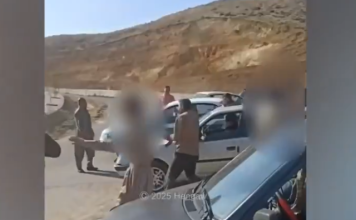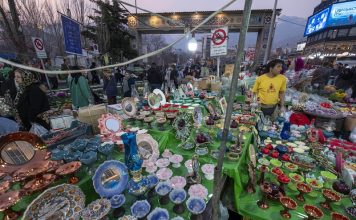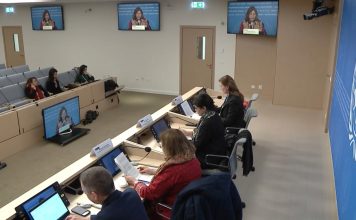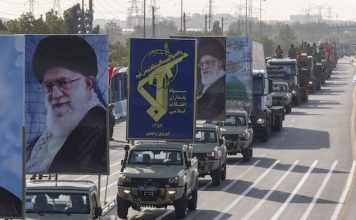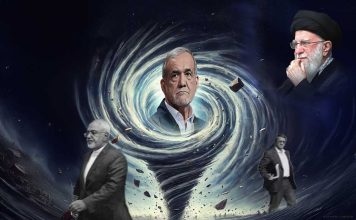In February 1979, when the Islamic Revolution overthrew the monarchy in Iran, 18-year-old Crown Prince Reza, the heir to the Pahlavi throne, had finished high school and was undergoing military training as a fighter jet pilot in the U.S.
The revolutionary wave that swept the nation not only forced the prince’s family out of the country, but also emboldened the newly established Islamic Republic and its Supreme Leader Ayatollah Ruhollah Khomeini to pressure the U.S. and other countries not to give the royal family a sanctuary.
Islamist students’ takeover of the American embassy in Tehran in November 1979 and the seizure of 52 diplomats as hostages for 444 days was part of a broader tactic by the Islamic Republic to pressure the U.S.
[aesop_image img=”https://kayhanlife.com/wp-content/uploads/2021/12/2021-12-09T105616Z_1077431208_RC2YAR965E8Z_RTRMADP_3_IRAN-NUCLEAR-USA-scaled.jpg” panorama=”off” credit=”REUTERS./ ” align=”center” lightbox=”off” captionsrc=”custom” caption=”FILE PHOTO:
State sponsored demonstrators stand in front of a wall of the former U.S. embassy with anti-U.S. murals during the 42nd anniversary of the U.S. expulsion from Iran, in Tehran, Iran. ” captionposition=”left” revealfx=”off” overlay_revealfx=”off”]
Prince Reza remained in the U.S. but later joined his family and his ailing father, the late Mohammad Reza Shah (1990-1980), in Cairo. Egyptian President Anwar Sadat (1918-1981) welcomed the Pahlavi family with open arms.
Mohammad Reza Shah, the second Pahlavi monarch, died of cancer on July 27, 1980. He was buried in Cairo’s Al-Rifa’i Mosque. Besides Empress Farah Pahlavi, Iranians from around the world visit the Shah’s grave in Cairo every year.
In the decades that followed the Constitutional Revolution (August 1906), Iran entered a period of social and economic development under the leadership of the founder of the Pahlavi Dynasty, Reza Shah (1878-1944).
Reza Shah’s reign (from 1925 to 1941) aimed to create a “new Iran” with modern civic institutions, including the army, the Judiciary, and health and education ministries. He rescued the nation from the grip of radical and reactionary clerics who had prevented the country’s development.
Reza Shah died on July 26, 1944, in South Africa. He was 66 years old. His body was embalmed and buried in Cairo’s Al-Rifa’i Mosque. The 28-year-old monarch, Mohammad Reza Shah, moved his father’s remains to Tehran in 1950, where it was buried in Shah Abdol-Azim.
[aesop_image img=”https://kayhanlife.com/wp-content/uploads/2018/04/reza-shah-01.jpg” panorama=”off” align=”center” lightbox=”off” captionsrc=”custom” caption=”Reza Shah’s Mausoleum in 1950s. ” captionposition=”left” revealfx=”off” overlay_revealfx=”off”]
Ayatollah Khomeini’s chief justice of the revolutionary courts, Seyyed Sadegh Khalkhali, known for his summary executions of prisoners and dissidents, ordered Reza Shah’s Mausoleum to be demolished in 1980.
[aesop_image img=”https://kayhanlife.com/wp-content/uploads/2018/04/reza-shah-04.jpg” panorama=”off” credit=”KL./” align=”center” lightbox=”off” captionsrc=”custom” caption=”Reza Shah’s Mausoleum after the Islamic revolution.
” captionposition=”left” revealfx=”off” overlay_revealfx=”off”]
Reza Shah had been forced into exile by the allies of World War II. He never intended to leave Iran for good. With a heavy heart filled with the love of his country, Reza Shah and several family members moved to Mauritius in September 1941.
On April 22, 2018, Iranian state media reported that workers excavating the ruins of Reza Shah’s mausoleum had found an embalmed body. The discovery coincided with nationwide protests which had started a few months earlier, during which the crowd shouted, “Reza Shah, May God bless your soul.”
Photographs published in the media seemed to confirm that the embalmed body was that of the late Pahlavi monarch. There were rumors that his son had taken Reza Shah’s body out of the country when he left Iran in 1979, given that Reza Shah’s remains were never found when his mausoleum was demolished in 1980. However, Empress Farah has denied these claims emphatically.
It is unclear what the Islamic Republic has done with the embalmed body since its discovery four years ago. Shortly after its discovery, a member of the Islamic City Council of Tehran confirmed that the embalmed body was that of Reza Shah and that it had been buried once again near where it was found.
The brief history of the founder of the Pahlavi dynasty and his successor offers vital context to the crucial role of Crown Prince Reza as the next monarch.
Those who lived in Iran before the 1979 Revolution, and the generations born after that — who have had access to Persian-language media outlets abroad, including Kayhan London and opposition radio and TV stations — can compare the conditions in the country during the Pahlavi era with those under the Islamic Republic in the past 43 years.
A common saying of Iranians currently is that “they see their future in the pre-Islamic Revolution period.”
The climate and conditions of the time shaped Reza Shah into a benevolent authoritarian ruler whose principal aims were to protect the territorial integrity of the country and to usher in a new era of development and progress by creating a civil society. Reza Shah’s efforts to modernize Iran coincided with a battle to save democracy fought in the heart of Europe by the West against Fascism and Nazism.
Reza Shah ultimately abdicated in 1941 in favor of his 20-year-old son, who continued his work.
Mohammad Reza Shah took the reign under challenging circumstances. Although he continued successfully on the path set by his father, the young monarch did not benefit politically from the country’s social and economic growth. His reign was beset with the “Red Scare” (communism threat) from Iran’s neighbor to the north, the Soviet Union; the 1972 Afghanistan coup d’etat, which gave the Soviet Union access to Iran’s eastern neighbors; and an oil and energy crisis in the country.
Meanwhile, the global Islamist movement found its most promising center for development and expansion in Iran, especially when it took control of the country after the fall of the Pahlavi dynasty.
The new generation of Iranians who love their country and cherish democracy are aware of the social and economic achievements of the Pahlavi era, despite the Islamic Republic’s propaganda and concerted effort to erase ancient and modern Iranian history and destroy the art and culture that flourished after the Constitutional Revolution.
Iranians have shouted slogans praising the Pahlavi era in every protest since the fall of 2017. Iranians crave the security, stability, and relative prosperity the nation enjoyed under the first two Pahlavi monarchs.
Crown Prince Reza Pahlavi Says People of Iran Are ‘Ultimate Decision-Makers’
Iranian Political Prisoners Issue Statement in Support of Prince Reza Pahlavi
The Pahlavi era ensured all citizens’ civil liberty and legal and human rights, irrespective of race, ethnicity, gender, and religious beliefs. Empress Farah played a critical role in developing the country’s cultural life and promoting women’s rights.
Although the Islamic Republic prevented Crown Prince Reza from ascending to the throne, he followed in his father and grandfather’s footsteps while living in exile to realize a “new Iran” — derailed by the Islamic Republic — by entering a “new covenant” with the Iranian people.
On September 18, 2020, Prince Reza explained his “new covenant” to Iranians, a roadmap to overcome the country’s problems under the banner of “no to the Islamic Republic.” The Iranian people and various political groups welcomed the Prince’s message and vision.
Besides the apparent achievements of Reza Shah and his son Mohammad Reza Shah, the political views of Crown Prince Reza have endeared the Pahlavi family to Iranian society.
Prince Reza was in his early 20s when he pledged allegiance to the Constitution, during which, as he recounts, he reminded people that although they turned their back on the institution of monarchy, it will never abandon them.
At 62, Prince Reza continues to call for the establishment of democracy in Iran, an aim that his father and grandfather could not realize during their reigns, given that their priority was to unify and rebuild the country.
[aesop_image img=”https://kayhanlife.com/wp-content/uploads/2019/01/2018-01-03T155557Z_1521067218_RC1E1D2CA7A0_RTRMADP_3_IRAN-RALLIES-MONARCHY-e1547027942734.jpg” panorama=”off” align=”center” lightbox=”on” captionsrc=”custom” caption=”FILE PHOTO: Reza Pahlavi. REUTERS./” captionposition=”left” revealfx=”off” overlay_revealfx=”off”]
The first two Pahlavi monarchs ruled Iran in a period when the West was in an existential fight to save a not fully realized democracy from the clutches of the fascists and the Nazis.
Reza Pahlavi’s aspirations for a democratic Iran are apparent in his speeches, interviews, and books, including “Winds of Change: The Future of Democracy in Iran,” written in English and published by Regency House Publishing in 2022, and “Iran: L’Heure du Choix: Entretiens” (Iran: Deciding Hour), written in French and published by Éditions Denoël publishing house in 2009.
The Islamic Republic prevented Crown Prince Reza from serving the Iranian people as his father and grandfather had done. Instead, the Iranian people have endured oppression, hardship, and tragedy under the despotic rule of the Islamic Republic over the past 43 years.
Those who rejected the institution of monarchy believed the alternative would bring about freedom, safety, and prosperity far more significant than those they had experienced under Pahlavi rule, when in fact, the alternative was the exact movement defeated by the Constitutional Revolution and forced back into their dark cloisters during the Pahlavi era.
These are issues that Reza Pahlavi has written about in the past couple of decades. The principal thrust of his thought is how to get through this period and reach a future where Iranians achieve liberty and free elections and accept the responsibility to safeguard what they have gained through their liberty and free elections.
In today’s world, such freedoms can only be achieved in Iran through the establishment of democracy, human rights, and unity through diversity. Prince Reza Pahlavi has chosen this as his mission, irrespective of whether people want him or his eldest child as the next monarch or prefer to decide on a republic based on democracy and human rights. He represents a modern governing system that safeguards people’s freedom to determine their political, economic, and social fate.
Despite the Islamic Republic’s brutal treatment of people, the crowd has been shouting pro-Pahlavi slogans in nationwide protests in recent years. Meanwhile, surveys and opinion polls conducted by state and independent agencies have shown that many Iranians favor the revival of the Pahlavi era with the promise of peace, stability, and economic prosperity.
The popularity of Crown Prince Reza is not about a person or mere nostalgia for a bygone era, but the Pahlavi dynasty’s love of Iran and its tangible achievements in bettering the life of the Iranian people. Iranian people want liberty, prosperity, and freedom to determine their destinies.
The Iranian people wish to establish friendly and mutually beneficial ties with their neighbors and the international community. They want to lead ordinary lives in a stable country managed by a regular governing system.
The first two Pahlavi monarchs provided an environment for three generations of Iranians. Prince Reza embodies hope for immediate change and a bright future for many young Iranians.
Empress Farah Pahlavi Says She Supports Iranians’ Calls for Monarchy
Prince Reza’s “new covenant” and speech on June 3 laid out his vision. Reza Pahlavi does not make unrealistic and empty promises to Iranians. While his roadmap includes following in his father’s and grandfather’s footsteps, he urges all Iranians to take responsibility for completing this journey.
Prince Reza’s roadmap has instilled hope in the hearts of his intended audience and gained the support of political groups which have put aside personal and factional interests in favor of serving the country and the Iranian nation.
For this reason, the Islamic Republic has escalated its political and religious propaganda in recent years. Iran’s Supreme Leader Ayatollah Ali Khamenei ordered the “Explanation Jihad” established in November 2021 to curb the increasing popularity of the Pahlavis. The government’s 2022-23 budget allocated nearly $4 to the Ministry of Culture and Guidance’s Press Office for the “Explanation Jihad” to “combat soft war.”
The Islamic Republic believes that the solidarity between the Pahlavis and the public poses an existential threat to its survival.
The international community and the West must take the covenant between Reza Pahlavi and Iranians seriously if it wants to neutralize the global threats posed by the Islamic Republic’s missile program, nuclear activities, and regional ambitions. It must take notice of the protesters’ slogan “no to the Islamic Republic” and hear the voices of those proposing a practical approach to establish peace and stability in the region, including Crown Prince Reza Pahlavi.
Trying to appease the Islamic Republic will not be in the interests of the Iranian people, the region, or world democracies. This has been proven through 43 years of concrete experience.



